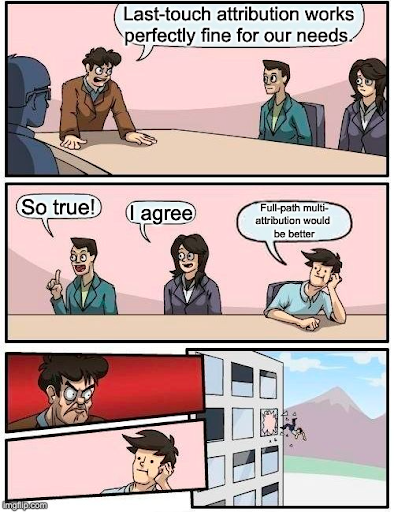We, as marketers, have been forced to live with a profound and undiscussed assumption for years. Saying it out loud is taboo. We cringe every time we have to present our marketing and sales funnel findings, in the hope that no one points out our assumption as false. The assumption? That only one prospect interaction influenced their buyer’s journey and that we should attribute all credit to that single source.
We all know this isn’t valid. Still, we stuck by our marketing automation platforms (MAPs) over the years, believing that last-touch attribution was the only serviceable attribution model. We told ourselves that alternate attribution models were too complex to implement, and so confusing that gaining actionable insights wasn’t realistic. And thus, we present single-touch attribution as though it makes any real sense.
That may have been true at one point, but it is not true today. Welcome, multi-touch attribution.
There is good news. Marketing automation platforms like HubSpot and other point solution attribution companies are making sense of the attribution conundrum so that we mere mortals can finally start to leverage multi-touch attribution here in the real world.
What is multi-touch attribution?
By attributing credit to marketing campaigns that lead to sales, we gain a valuable metric to measure the effectiveness of our efforts (in other words, it justifies our jobs). Traditionally, we have made the rather extreme assumption that 100% of the credit should be given to the last touchpoint.
Mostly, we agreed to this because it is by far the easiest to implement and interpret. But it also mischaracterizes the path that our buyers take as they learn and interact with a brand before buying.
Multi-touch attribution is the solution for this flawed assumption, but it requires some thought to pick a suitable model for your business, and it can make interpretation more challenging. Nothing’s perfect, right?
There are several standard multi-touch attribution models worth considering if you are thinking about making the leap.
Multi-touch attribution models
The main difference between multi-touch and single-touch models is that multi-touch allows you to give credit to more than one touchpoint in the journey. So the questions become: how much credit should we give to each touchpoint, and should that credit change over time?
To help illustrate the models, let’s consider the following use case. Imagine you recently purchased a pair of snazzy shoes online. You first heard about them through an ad while listening to your favorite podcast. Then you searched for the brand while bored at work that following Monday, and checked out a few pairs you liked but didn’t buy.
After that, you saw a few display ads (yup, you got retargeted). Then a week later, you saw a paid ad on social advertising a sale, and you clicked through and added a pair to your cart. You started to check out, but you got an email from your boss and forgot to come back. The next day, you got an abandoned cart email with an additional 5% off for completing your purchase (tricky marketers!), so you click through and buy your first pair.
If this were a single-touch model using last-touch attribution, we would have said that the paid ad was 100% responsible for the sale, even though you had lots of other interactions before you ever saw the ad. If it were a first-touch model, it would have given all the credit to the podcast, assuming you could ever trace that info back. Neither tells the full story.
Linear multi-touch attribution model
This is the most straightforward, because it gives equal credit to each touchpoint along the journey. In this case, we would give 20% credit to each of the five interactions.
The benefit of this model is that we now have a fuller picture of what happened for this user and all the different elements that were included. If we had only been using last-touch, we would not have attributed any success to the other campaigns that influenced the sale.
On the other hand, we’ve given equal credit to campaigns that clearly did not influence the sale equally. It’s hard to imagine that the display ad you saw on YouTube for three seconds before clicking ‘skip ad’ was as influential as the abandoned cart email with the discount. But this model treats them with the same level of credit.
U-shaped multi-touch attribution model
As you may have guessed by the very descriptive name, the U-shaped model gives more credit to the first and last touches in the journey. Typically, 40% is given to each of the first and last touches; then, the remaining 20% is split between the remaining touches.
In the example, we would now give equal weight to the podcast ad and the abandoned cart nurture email, and the display and paid social ads would have less credit for the sale.
This model more closely resembles the reality of which interactions impacted a sale as compared to the linear model, but it is by no means perfect. It fails to acknowledge that the abandoned cart email was only possible because the paid social ad sent you to the website where you started a cart and converted into a known lead/opportunity (depending on how you define it).
And this leads us to…
W-shaped multi-touch attribution model
This model gives about 30% of the credit to three critical touchpoints: the first touch, lead creation, and opportunity creation. It leaves the remaining 10% to be distributed across other interactions. This is even closer to reality for our use case.
The challenge is that it’s not always easy to bucket lead and opportunity creation. In this eCommerce example, the lead and the opportunity were created simultaneously, and it’s rare that you would have leads that are not also opportunities for most eCommerce consumer goods. This is less of an issue in a B2B setting, where there is a long sales cycle and phases are easily bucketed.
Full-path attribution model
The full-path model gives 22.5% credit each to the first touch, lead creation, opportunity creation and last touch conversion points. It then splits the last 10% across all remaining interactions. This is also an excellent solution for B2B companies and longer sales-cycle organizations because it highlights the different combinations of interactions that lead to the final sale. This is probably the most popular model because it gives a more balanced view of credit while minimizing skew from overweighting any particular aspect of the conversion process.
Time decay multi-touch attribution model
Like the linear model, the time decay model gives equal weight to all interactions, but it also factors time into the equation. This model gives more weight to interactions that happened more recently, typically at the bottom of the funnel. It’s worth mentioning because it takes a different spin on attribution, but it may not be the best fit for all companies. However, for B2B companies where there is a long sales cycle that relies on a lot of nurturing to convert opportunities, this can add a lot of value by highlighting the final few interactions that brought the prospect over the finish line.
Cool, so now what?
The good news is that many MAPs are now incorporating multi-touch attribution into their standard offerings, like HubSpot’s Marketing Hub. The downside is that you’ll have to shell out for their enterprise subscription, custom reporting, and use their Sales Hub deals object to get full functionality.
But if you do meet those requirements, Hubspot can pretty much cook up the reports for you automatically with the flip of a switch. This may seem like a fever dream for those of us who have tried to build this type of reporting manually in the past.
HubSpot offers several attribution models, including first touch, last touch, W-shaped, U-shaped, linear, and full-path. So you could even play around with them to figure out which model works best for your company.
You’re not on HubSpot, and your MAP doesn’t offer multi-touch attribution yet? Fear not. There are tons of solutions on the market. You’ll need to consider which data sources you want to integrate and whether you are focused on tracking mobile only, desktop only, or across devices. Check out this article for a rundown of options and insight into which types of businesses each are best suited for.
Is it really worth it?
Honestly, the answer is yes. Even if you have made peace with the fact that last-touch attribution is flawed and are hesitant to make a change now, it really is worth it. Ultimately, the purpose of an attribution model is to help marketers make a powerful and data-driven argument that what they are doing is having a positive impact on the bottom line and creating ROI.
The biggest flaw in the last-touch model is that you are only ever able to give credit to interactions at the bottom of the funnel, which further undermines the perceived importance of top-of-funnel content.
With a fully fleshed-out multi-touch attribution model, the case that a marketer can make to our sales counterparts and the executive team is infinitely stronger. We can now show how all of the pieces fit together and tell a complete story when we ask for budget or when defending our position on content strategy.
It may seem like a ton of work, but with some due diligence, you may find that implementing multi-touch attribution is not as far out of reach as you might imagine.












